Renewable energy in Kenya
The renewable energy sector in Kenya is among the most active in Africa. In Kenya, investment grew from virtually zero in 2009 to US$1.3 billion in 2010 across technologies such as wind, geothermal, small-scale hydro and biofuels. This is not saying that Kenya was never active in the renewable energy sector. Kenya is Africa's first geothermal power producer[1] and leads Africa in the number of solar power systems installed per capita. It is still the largest producer of geothermal power in Africa today at 200 MW [2] with only one other African country producing geothermal power, Ethiopia.In 2011, Kenya was also the first country in Africa to open a carbon exchange.[3]
Geothermal power
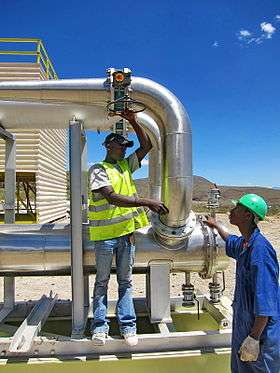
Currently geothermal energy accounts for 20% of total installed capacity of the Kenyan grid. Kenya is the first African country to tap geothermal power and the largest producer of geo-energy, harnessing power from steam released by hot rocks beneath the Rift valley. The abundant sun and wind are also being harnessed in a variety of projects: of these, the Lake Turkana project is the most audacious, both because of the scale and the location.[4] Kenya has the capacity to produce 10 GW of geothermal energy.[5]
Geothermal has a prominent place in Kenya's overarching development plans.[6] These include the Vision 2030, the National Climate Change Action Plan (NCCAP), and the current ‘5000+ MW in 40 months initiative’. Geothermal power has the potential to provide reliable, cost-competitive, baseload power with a small carbon footprint, and reduces vulnerability to climate by diversifying power supply away from hydropower, which currently provides the majority of Kenya's electricity. Kenya has set out ambitious targets for geothermal energy. It aims to expand its geothermal power production capacity to 5,000 MW by 2030, with a medium-term target of installing 1,887 MW by 2017. As of October 2014, Kenya has an installed geothermal capacity of approximately 340 MW. Although there is significant political will and ambition, reaching these ambitions is a major challenge [7]
Hydroelectricity
Hydroelectric power in Kenya currently accounts for about 49% of installed capacity, which is about 761MW. However, the Kenyan Government is strongly pushing for a shift to other alternative resources of electricity generation. By 2030 hydro power will only account for 5% of total capacity at 1,039 MW.[8]
Hydroelectric power stations in Kenya
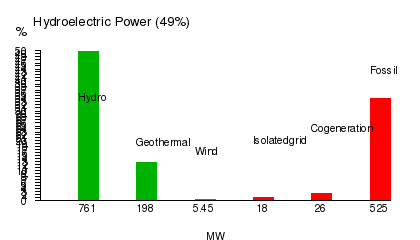
|
- See main article: List of hydro-electric power stations in Kenya
Seven Forks Scheme
The scheme generates almost all of Kenya's Hydro-electric power. It generates approximately 530 MW of power. It includes
- Masinga Power Station
- Gitaru Power Station
- Kamburu Power Station
- Kindaruma Power Station
- Kiambere Power Station
- Planned
- Grand Falls
- Mutonga
- Sang’oro Hydro
- Kindaruma 3rd Unit & Upgrading Unit 1&2
Gitaru Power Station
Gitaru Power Station is the biggest power station in Kenya in terms of installed and effective capacity. It can produce 222 MW[9] and was commissioned in 1978 (145 MW) and 1999 (80 MW). It is one of the stations included in the Seven Forks Scheme.
Wind power
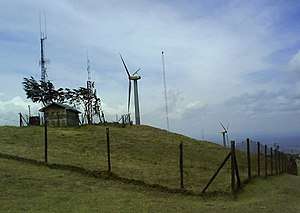
Solar power
Kenyans are a world leader in the number of solar power systems installed per capita. More Kenyans are turning to solar power rather than connections to the country's electric grid. This is due to relatively high connectivity costs to the grid and the abundance of solar power in Kenya.[10]
Kenya has several notable solar power distributors including M-Kopa with locally adopted payment schemes including pay-as-you-go and microfinance.[11] The World Bank and International Finance Corporation (IFC) have partnered as part of a Lighting Africa initiative.[12] Western companies have also helped sponsor efforts to introduce decentralized solar power solutions in the country.[13][14]
Several solar power stations are operational or under construction are 55 MW Garissa, 40 MW Rumuruti, 40 MW Radiant, 40 MW Eldosol, 40 MW Alten, 10 MW Kenyatta University, 52 MW Malind and 50 MW Kopere.
Renewable future targets
Kenya aims to produce 19,200 MW against a demand of 15,000 MW by 2030. All this is shown in the table below:
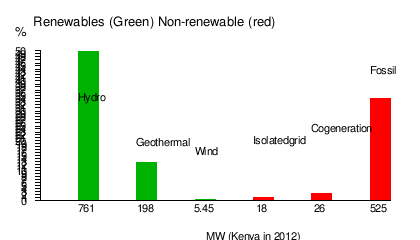
|
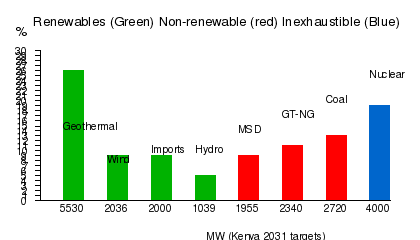
|
See also
- Energy in Kenya
- List of countries by renewable electricity production
- Wind power in Kenya
- Geothermal power in Kenya
- Hydroelectric power in Kenya
- Renewable energy by country
References
- "GDC - Geothermal Development Company". Gdc.co.ke. Retrieved 13 April 2018.
- "Kenya on the cusp of a geothermal energy boom". theeastafrican.co.ke. Retrieved 13 April 2018.
- Gachenge, Beatrice (24 March 2011). "Kenya opens Africa's first carbon exchange". reuters.com. Retrieved 13 April 2018.
- Nairobi, Clar Ni Chonghaile in (28 March 2012). "Kenya to host sub-Saharan Africa's largest windfarm". the Guardian. Retrieved 13 April 2018.
- "Archived copy". Archived from the original on 2013-11-05. Retrieved 2013-08-06.CS1 maint: archived copy as title (link)
- Sarkodie, Samuel Asumadu; Ozturk, Ilhan (2020-01-01). "Investigating the Environmental Kuznets Curve hypothesis in Kenya: A multivariate analysis". Renewable and Sustainable Energy Reviews. 117: 109481. doi:10.1016/j.rser.2019.109481. ISSN 1364-0321.
- "INSIDE STORY: Nationally Appropriate Mitigation Action (NAMA) to accelerate geothermal power: Lessons from Kenya - Climate and Development Knowledge Network". cdkn.org. Retrieved 13 April 2018.
- "Archived copy" (PDF). Archived from the original (PDF) on 2013-06-13. Retrieved 2013-08-04.CS1 maint: archived copy as title (link)
- "Welcome to KENGEN - KENGEN".
- "Definitive Solar" (PDF). Definitivesolar.com. Retrieved 13 April 2018.
- "One Degree Solar". onedegreesolar.com. Retrieved 2016-07-25.
- "About Us | Lighting Africa". Lightingafrica.org. Retrieved 2016-07-26.
- "Orb Energy Secures Funding to Replicate Indian Business Model in Kenya | Lighting Africa". Lightingafrica.org. 6 February 2015. Retrieved 2016-07-26.
- "Why Coke Is Bringing Solar Power To Rural Kenya". Co.Exist. 2013-06-04. Retrieved 2016-06-04.
- "Archived copy" (PDF). Archived from the original (PDF) on 2013-06-13. Retrieved 2013-08-04.CS1 maint: archived copy as title (link)
External links
| Wikimedia Commons has media related to Renewable energy in Kenya. |